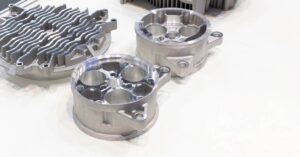In the diverse universe of manufacturing, die casting reigns as one of the most efficient, cost-effective, and versatile production methods.
It involves forcing molten metal into a mold cavity under high pressure, which, when solidified, results in a detailed, durable, and dimensionally accurate component.
Among the myriad of materials used for die casting, aluminum and zinc metals are particularly prized.
They both bring unique strengths to the table, offering manufacturers the flexibility to choose a material based on the specific requirements of their projects.
Let’s explore these two popular die casting materials and delve into their unique properties.
Aluminum Die Casting
Aluminum, a material renowned for its lightweight nature, strength, and impressive thermal properties, holds a prominent position in the die casting sector. This notably light metal contributes to end-product weight reduction while maintaining high durability and robustness – qualities that are highly sought after in industries such as aerospace and automotive.
One of the fundamental traits of aluminum is its exceptional resistance to corrosion. This makes it an excellent choice for components exposed to harsh environments or demanding weather conditions. Whether it’s the aluminum alloy wheels of your car or the housing of your smartphone, these products have all benefited from the incredible resilience of die cast aluminum.
The superior thermal conductivity of aluminum ensures efficient heat regulation, a vital element in applications like electronic heat sinks or vehicle engine parts. Furthermore, this metal’s full recyclability underscores it as an eco-friendly choice, aligning with the rising global focus on sustainable manufacturing methods.
Zinc Die Casting
While aluminum brings a lot to the table, zinc is equally advantageous in its unique way. In fact, zinc alloys are the easiest to cast among all the die cast metals, thanks to their excellent fluidity. This fluidity allows for precision casting of intricate shapes and thin wall components, producing detailed parts that would be difficult to achieve with other materials.
Zinc’s exceptional strength and hardness mean that it can withstand a considerable amount of wear and tear. It’s widely used in industries like consumer electronics and automotive, where durability is a non-negotiable requirement.
One of zinc’s superpowers lies in its superior electroplating and finishing characteristics. Zinc die cast components can be beautifully finished with a variety of coatings – chrome, brass, gold, and even a simple paint job looks great on zinc. This makes zinc perfect for applications where aesthetics matter, like decorative hardware or high-end consumer electronics.
An added advantage of zinc is its low melting point, which allows for faster production cycles. This results in lower energy consumption and costs, making zinc an economically sound choice for high-volume manufacturing production runs.
Aluminum vs. Zinc Die Casting: Which to Choose?
Selecting between aluminum and zinc for a die casting project comes down to the specific needs of your application. If you require a lightweight, corrosion-resistant component with excellent thermal conductivity, aluminum is the material of choice. On the other hand, for intricate designs requiring superior strength and a beautiful finish, zinc is an excellent candidate.
Enjoy Many Benefits with Both Materials
Regardless of the material selected, the die casting process offers a host of benefits, including high production speed, the ability to create complex shapes, and exceptional part-to-part repeatability. Both aluminum and zinc have their unique place in the wide spectrum of applications, ensuring the continued importance of die casting services in modern manufacturing.
Die casting with aluminum and zinc is a testament to the evolving face of manufacturing – one that emphasizes precision, efficiency, and versatility. The choice of material may vary based on application requirements, but the essence remains the same: to create superior, reliable, and high-quality components that form the backbone of our everyday lives.
As we progress further into the 21st century, the relevance of die cast metal materials like aluminum and zinc is only set to increase. Their unique properties and advantages underline their indispensable role in shaping the future of manufacturing. The beauty of die casting lies in its adaptability and range – and aluminum and zinc are stellar examples of this phenomenon in action.






